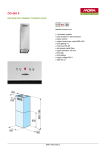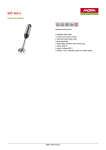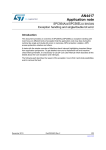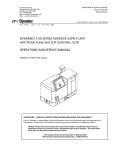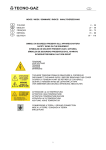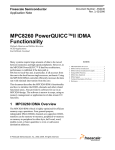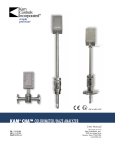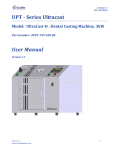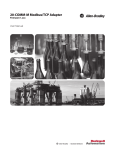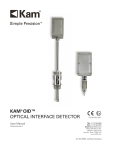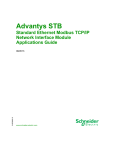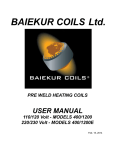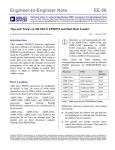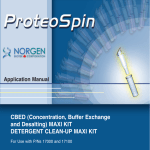Download KAM® OWD® OIL WATER DETECTOR
Transcript
PTB 08 ATEX 1026 API COMPLIANT An ISO 9001 certified company KAM® OWD® OIL WATER DETECTOR User Manual OWDMANUAL-0213 TEL +1 713 784 0000 FAX +1 713 784 0001 Email [email protected] KAM CONTROLS, INC. 3939 Ann Arbor Drive Houston, Texas 77063 USA www.KAM.com TABLE OF CONTENTS SECTIONTITLEPAGE 1 Introduction •Available Models and Mounting Options •Theory of Operation •Features •Applications 2 2 3 3 3 2 Specifications •Specifications •Dimensional Drawings 4 4 5 3 Installation 9 •Installation Flow Requirements 9 •Locations/Applications 10 •General Do's and Don't's 13 •Main Line 14 •Fast Loop 17 •Wiring 20 4 OWD Operation •Hyperterminal Software •Calibration •Changing the Range •Modbus Interface 22 22 26 27 27 5Maintenance 28 •Cleaning/Inspection 28 •Troubleshooting 28 •Antenna Replacement 29 APPENDIX A: Modbus Registers 35 CAUTION: When installing the OWD® sensor in a pipeline containing petroleum products, petrochemicals, waste waters with the presence of pressure & temperature, and high-pressure steam refer to the Pipeline Operators’ "Health, Safety and Environmental Policy Procedures" to ensure safe installation. KAM CONTROLS, INC. reserves the right to make changes to this document without notice. OWDMANUAL 0213 1 KAM CONTROLS, INC. INTRODUCTION AVAILABLE MODELS and MOUNTING OPTIONS FIG. 1-1 FIG. 1-2 Recommended KAM® SMS™ Static Mixing Spool Recommended KAM® SMS™ Static Mixing Spool Full-opening Ball Valve Full-opening Ball Valve Q Q Option 1: Retractable OWD® on a main pipe with 2", 3", or 4" flanged seal housing Option 2: Retractable OWD® on a main pipe with 2" MNPT seal housing FIG. 1-3 FIG. 1-4 Recommended KAM® SMS™ Static Mixing Spool Included KAM® SMS™ Static Mixing Spool P Q Q Q Option 4: 2" OWD® flow through sensor with integrated KAM® SMS™ Static Mixing Spool Option 3: Fixed-mount OWD® on a densitometer loop, with 1/2", 3/4", 1", or 2" FNPT OWDMANUAL 0213 2 KAM CONTROLS, INC. INTRODUCTION CONTINUED THEORY OF OPERATION Rugged, easy to use and extremely accurate, the KAM® OWD® Oil Water Detector is the ideal instrument for continuously monitoring water concentration in your pipeline. It is designed in accordance with API, ASTM, ISO, EI, UL, and DIN standards amongst others. Especially vital in production management, the OWD® sensor lets you maximize oil production versus produced water. The simplicity of design and quality of engineering employed in the OWD® sensor mean there are no moving parts. Patented microwave sensors measure the conductivity, dielectric, and both the real and imaginary part of permittivity of the fluid with an extremely high degree of accuracy, and measurement is fully automatic without the need for operator intervention or supervision. The output signal can be sent to Flow Computers, SCADA, PLC’s or to a Central Control Room for logging or display on chart recorders or monitors. The KAM® OWD® sensor also uses internal references to auto calibrate for drift caused by temperature changes of the electronics, the aging of the electronics components, fluid pressure, and fluid temperature. The KAM® OWD® flow through model can be used in an analyzer/densitometer loop, for process optimization where an accurate determination of water concentration is important, and it is vital to optimizing the desalinization process. Placed on the desalter sample line, or on each sample line, the KAM® OWD® flow through model provides real-time information about your desalter performance. To ensure the highest degree of accuracy, the flow must be homogenous. Installed upstream of your OWD® sensor, the patented KAM® SMP™ Static Mixing Plate or KAM® SMS™ Static Mixing Spool create a fully homogenous mixture in your pipeline. In low velocity situations, the use of a KAM ML Measurement Loop may be required in order to create a homogenous flow for measurement. Proper calibration, also key to complete accuracy, can be achieved in the field with the KAM® PKF Portable Karl Fischer Moisture Analyzer. Data from the PKF analyzer can then be entered into the OWD® sensor via IR port or corrected via RS232 at the flow computer. Because it can be inserted into your pipe or tank through a 2", 3", or 4" hot tap, the OWD® sensor helps you avoid costly drainage, the need for a bypass loop, or having to cut a section in the pipe. All wetted parts are machined from 316 stainless steel. Shaft lengths from 1 to 3 feet are available with off-the-shelf lengths coming in 12", 24", and 36". Metric and custom lengths are available. TABLE 1-5 MEASUREMENT CAPABILITIES: CALIBRATED RANGE AND ACCURACIES Range (water in oil) Accuracy (at listed range) OWDMANUAL 0213 0–5% 0.05% 0–10% 0.10% 0–30% 0.30% 3 0–40% 0.40% 0–100% 1.00% KAM CONTROLS, INC. SPECIFICATIONS Media: Crude oil, refined products and chemicals Material: Wetted parts - 316 stainless steel Fluid temperature: To 300ºF(149ºC/High temp model available to 600ºF(315ºC) Power requirements: 24 VDC/1 amp at 24 watts Accuracy: 1% of full range** Repeatability: +/- 0.01% Resolution: +/- 0.01% Minimum water detection: 100 PPM Outputs: Selectable 4–20 mA with adjustable range or 0–5 VDC Alarm relay RS232/RS485 Mounting: ½", ¾", 1" or 2" FNPT flow through (Other sizes, including metric, are available) 2" MNPT seal housing 2", 3", or 4" flanged seal housing Pressure ratings: ANSI 150, 300, 600, 900, 1500, 2500 Flow conditions: Well mixed in accordance with API MPMS Chapter 8, Section 2, Table 1 Sensor dimensions: Ø1.5" x 7" (38mmh x 178mm) EX enclosures: Sensor electronics - 3" x 6" x 3" (76mm x 152mm x 76mm) Shaft length: 12" to 36" (305mm to 914.4mm) Off-the-shelf lengths are 12", 24", and 36" (609.6mm, 762mm, 914.4mm,) Pipe Size: ½" to 48" (15mm to 1200mm) Weight: from 20 lbs. (9kg) * The KAM® OWD® must be installed in accordance with API MPMS Chapter 8, Section 2, Table 1. **If entrained gas is constant, its effect is factored out. If entrained gas is introduced or removed after OWD® calibration it will shift water cut measurement by approximately 1-2% for every 1% change in gas levels. OWDMANUAL 0213 4 KAM CONTROLS, INC. SPECIFICATIONS CONTINUED DIMENSIONAL DRAWINGS FIG. 2-1 OWD® SENSOR FOR 0–100% WATER SL Seal Housing C B A D E Electronics Enclosure Shaft Length ± .5" TABLE 2-2 FLANGE SIZE AND CLASS (SL) 150 300 600 1500 900 " INCHES MM INCHES MM INCHES MM INCHES MM INCHES MM 2 10.25 260 10.50 267 10.50 267 11.00 279 11.25 286 3 10.75 273 10.75 273 10.75 273 11.00 279 11.40 290 4 10.75 273 10.75 273 11.00 279 11.25 286 11.65 296 TABLE 2-3 DIMENSIONS INCHES MM A 1.48 38 B 4.5 114 C 7.25 184 D 4.7 119 E 5.5 140 OWDMANUAL 0213 Shaft Lengths are available in .5" (12.7mm) increments. Standard sizes are 24", 30", 36", 48", and 60" (609.6mm, 762mm, 914.4mm, 1219mm, 1524mm). 5 KAM CONTROLS, INC. SPECIFICATIONS CONTINUED FIG. 2-4 FLOW THROUGH OWD® SENSOR FOR 0–10% WATER FT F A B TABLE 2-5 DIMENSIONS INCHES C MM E D INCHES MM TABLE 2-6 FT (FLOW THROUGH) DIMENSIONS MM INCHES FNPT A 2.75 70 D 5.75 146 ½" 3.55 90.2 B 6 152 E 7.25 184 ¾" 3.35 85.1 C 3.5 89 F 4.7 119 1" 3.1 78.7 FIG. 2-7 FLOW THROUGH OWD® SENSOR FOR 0–100% WATER FT F A C B TABLE 2-8 DIMENSIONS INCHES MM D INCHES MM E TABLE 2-9 FT (FLOW THROUGH) DIMENSIONS MM INCHES FNPT A 2.75 70 D 5.75 146 ½" 1.55 39.4 B 4 152 E 7.25 184 ¾" 1.35 34.3 C 3.5 89 F 4.7 119 1" 1.1 27.9 OWDMANUAL 0213 6 KAM CONTROLS, INC. SPECIFICATIONS CONTINUED FIG. 2-10 2" OWD® FLOW THROUGH SENSOR FOR 0-100% WATER E B F A C TABLE 2-11 DIMENSIONS INCHES D MM INCHES MM A 4.25 108 D 14.5 ± .5 368 ± 13 B 3.75 95 E 7.25 184 C 2.05 52 F 4.7 119 FIG 2-12 2" WELD NECK OWD® SENSOR FOR 0-100% WATER E A F C B TABLE 2-13 DIMENSIONS INCHES D MM INCHES MM A 5.85 149 D 14.5 ± .5 368 ± 13 B 2 51 E 7.25 184 C 2 51 F 4.7 119 OWDMANUAL 0213 7 KAM CONTROLS, INC. SPECIFICATIONS CONTINUED FIG 2-14 2" OWD® FLOW THROUGH SENSOR WITH INTEGRATED KAM® SMS™ STATIC MIXING SPOOL A B 2" 150#, 300#, or 600# weld-neck flanges SS316 both ends C E E 2" sch. seamless pipe SS316 D TABLE 2-15 DIMENSIONS FLANGE SIZE INCHES MM A N/A 4.7 119 B N/A 7.25 184 C N/A 16.5 ± 0.5 419 ± 13 D 2" 150# 21 533 2" 300# 22 559 2" 600# 22 559 OWDMANUAL 0213 FIG 2-16 EE SS316 ½" sample valve with ½" pitot probe 8 KAM CONTROLS, INC. INSTALLATION INSTALLATION FLOW REQUIREMENTS PLEASE NOTE: In all KAM OWD Installations, the user should insure that the KAM OWD is installed in a turbulent flow with the Reynolds Number above 2000. Additionally, all KAM OWD's should be installed in accordance with API MPMS Chapter 8, Section 2, Table 1. For Low Range (0 – 5% Water in Oil) KAM OWD's, the sensor must be installed in the vertical down flow with a minimum flow velocity of 4 feet per second. A KAM SMS Static Mixing Spool is required if the flow velocity is between 4 and 7 feet per second. FIG. 3-1. For KAM OWD's operating in the Oil Continuous Phase, the sensor must be installed in the vertical down flow. A KAM SMS Static Mixing Spool is required if the flow velocity is between 4 and 7 feet per second. FIG. 3-1. For KAM OWD's operating in the Water Continuous Phase, the sensor must be installed in the vertical up flow. A KAM SMS Static Mixing Spool is required if the flow velocity is between 4 and 7 feet per second. FIG. 3-2. In situations where the flow velocity is less that 4 feet per second, KAM CONTROLS recommends the installation of a KAM ML Measurement Loop, incorporating suction and injection nozzles, a pump, and the OWD on a separate loop, ensuring a homogenous, high-velocity flow across the measurement sensor. FIG. 3-3. The KAM OWD may be installed horizontally when the minimum flow velocity is above 10 feet per second. FIG. 3-1 KAM® OWD® INSTALLATION VERTICAL FLOW DOWN FIG. 3-3 KAM® OWD® INSTALLED ON A KAM ML MEASUREMENT LOOP Q Q SUCTION KAM SMS STATIC MIXING SPOOL INJECTION LOW RANGE AND OIL CONTINUOUS PHASE OPERATION OWD FIG. 3-2 KAM® OWD® INSTALLATION VERTICAL FLOW UP WATER CONTINUOUS PHASE OPERATION The KAM ML Measurement Loop utilizes a pump to draw a representative flow from the main line into a circulation loop, incorporating a KAM OWD. The loop flow is injected back into the main pipeline upstream of the suction site, creating mixing and homogeneity prior to suction. A homogenous flow of 10-13 fps is maintained at the sensor head for the most accurate measurement at all times. KAM SMS STATIC MIXING SPOOL Q OWDMANUAL 0213 9 KAM CONTROLS, INC. INSTALLATION CONTINUED EFFECTS OF ENTRAINED GAS If entrained gas is constant, its affect is factored out. If entrained gas is introduced or removed after OWD® calibration it will shift water cut measurement by approximately 1-2% for every 1% change in gas levels. RECOMMENDED LOCATION BY APPLICATION In separator applications, KAM CONTROLS recommends that the OWD® sensor should be installed immediately downstream of the Separator Dump Valve in a vertical section of the pipe with the flow travelling downward. If possible, it should also be downstream of a KAM® SMS™ Static Mixing Spool or a KAM® SMP™ Static Mixing Plate. FIG. 3-4. FIG. 3-4 KAM® OWD® SEPARATOR INSTALLATION SEPARATOR Q KAM SMS STATIC MIXING SPOOL A second installation option for this application is in a horizontal pipe immediately downstream of the Separator Dump Valve in an OWD® spool integrated with a KAM® static mixer. FIG. 3-5. FIG. 3-5 KAM® OWD® ALTERNATE SEPARATOR INSTALLATION Q SEPARATOR KAM SMS STATIC MIXING SPOOL OWDMANUAL 0213 10 KAM CONTROLS, INC. INSTALLATION CONTINUED In a refinery/feedstock application, KAM CONTROLS recommends that the OWD® sensor be installed far enough in advance of the “Refinery Unit” to give time to take corrective action in instances where the OWD® senses unacceptable high water levels. FIG. 3-6. FIG. 3-6 KAM® OWD® REFINERY INSTALLATION KAM® SMS™ STATIC MIXING SPOOL CAT CRACKER/ BOILER Q For ideal performance in desalter applications, the desalter tank should incorporate a progressive series of 8 sample lines, each with its own draw-off valve and flow-through OWD® sensor, plus an additional OWD® sensor located on the outgoing oil line. FIG. 3-7. FIG. 3-7 KAM® OWD® IDEAL DESALTER INSTALLATION Q Q Q Q Q OWDMANUAL 0213 11 KAM CONTROLS, INC. INSTALLATION CONTINUED For optimal batch detection, Kam Controls recommends that you install the in-station OWD® sensor at the first accessible pipeline location inside the terminal fence-line — upstream of the interface cut valve(s). This allows the operator ample time to open/close the cut valves prior to the arrival of the product interface. KAM Controls also strongly recommends that you utilize a preview (or out-station) OWD® sensor. This lets the operator decide how to optimize each batch cut prior to actually making the batch cut at the in-station and gives TERMINAL FENCE the operator more confidence in their decisions as well as the time to identify and resolve any issues that may arise during a critical interface. FIG. 3-8. FIG. 3-8 OPTIMAL BATCH DETECTION OWD® INSTALLATION O W D O W D Terminal fence line O W D Typically 1-2 Miles Out-station/Preview OWD® OWDMANUAL 0213 In-station OWD® 12 KAM CONTROLS, INC. INSTALLATION CONTINUED GENERAL INSTALLATION DO'S AND DON'TS Always install OWD® sensors with the electronics enclosure shaded from direct sunlight. DO NOT use Teflon tape on threads connecting to the OWD® flow through sensor. DO use liquid thread sealant. OWDMANUAL 0213 13 KAM CONTROLS, INC. INSTALLATION CONTINUED PRIOR TO INSTALLATION Remove all the protective packaging materials, and ensure that the OWD® sensor was not damaged during transit. REMINDER: Please refer to the Installation Flow Requirements on P. 9 of this manual to ensure proper sensor placement where at all possible. Flow conditions must satisfy API MPMS Chapter 8.2 requirements in order to achieve accurate OWD performance. In cold weather, if OWD is exposed to an open environment, KAM CONTROLS recommends operators insulate the OWD, and if the pipeline is heated that the heating trace be extended to include the OWD. If the pipeline is not going to flow for extended amount of time and the pipe is not heated then OWD should be taken out to avoid damage to the sensor probe by freezing water. INITIAL CALIBRATION Though the OWD has been calibrated in the factory, operators should conduct an initial calibration in process conditions. This can be done in two ways: Off-line: Prior to installation, operators can go through the procedures for off-line calibration outlined on page 26 of this manual. This method requires samples of 100% produced water and dry oil or oil with a known percentage of water. On-line: After installation, operators can follow calibration procedures for in-line calibration outlined on page 26 of this manual. This method requires accurate sampling and sample processing. MAIN LINE INSTALLATION The KAM® OWD® sensor should be installed according to FIG. 3-13. A full-opening ball valve is used to isolate the OWD® sensor from the pipeline during installation or removal. The seal housing of the OWD® sensor allows the probe to be inserted and removed from the pipe under pressure and flow conditions. It is the user’s responsibility to ensure that the OWD® sensor be placed at the most representative point within the flow profile (see location recommendations above). The OWD® sensor should be inserted so that the window of the probe is located in the center of the diameter of the pipeline. FIG. 3-13 KAM® OWD® INSTALLED ON A MAIN PIPE Locking Collar Seal Housing Full-opening Ball Valve Note: If line pressure exceeds 100 psi, use a KAM® IT Insertion Tool when installing/removing the KAM® OWD® sensor. OWDMANUAL 0213 Socket Cap Screw 14 KAM CONTROLS, INC. INSTALLATION CONTINUED 1. Prior to mounting verify that the tip of the sensor is all the way inside the seal housing. FIGS. 3-14, 3-15. 2. If sensor is not fully enclosed inside the seal housing, pull the shaft back until the probe is all the way in the seal housing and tighten the Socket Cap Screws on the locking collar. This will prevent the OWD® shaft from sliding and the probe from getting damaged during mounting. FIG. 3-14 FIG. 3-15 3. Measure the distance (D1) from the outside diameter of main pipe to the end of the connection where the OWD® sensor is going to be installed. FIG. 3-16. FIG. 3-16 D1 D1 4. Calculate the minimum insertion distance for the OWD®. Minimum insertion distance (MID) = D1 + Pipe Wall Thickness (WT) + Gasket Thickness + A (See TABLE 3-16) Example for D1=16", WT =1/4", Gasket Thickness=1/8" and a 0-100% OWD® sensor: MID = 16 + 1/4 + 1/8 + 3 MID = 19 3/8" or 19.375" TABLE 3-17 OWD® WATER RANGE A/INCHES 0-10% SENSOR 5" 0-100% SENSOR 3" OWDMANUAL 0213 15 KAM CONTROLS, INC. INSTALLATION CONTINUED FIG. 3-18 5. Measure the calculated MID from the top of the Locking Collar and place a mark with a permanent marker or tape on the Shaft. FIG. 3-18. MID 6. Bolt or screw the OWD® sensor to the valve or designated installation location. (KAM CONTROLS recommends using thread sealant and not Teflon tape for the threaded OWD®). 7. Open full opening valve. 8. Loosen Socket Cap Screws on the locking collar. 9. Push OWD® sensor in until the mark is at the top edge of the locking collar. Ensure that OWD® flow indicator is aligned with pipeline flow direction. FIG. 3-19. FIG. 3-19 Mark Hex Nuts 10. Re-tighten the Socket Cap Screws. 11. Tighten the hex nuts holding down the Locking Collar one half turn. (Fig. 3-19) These should never be overtightened. Their major function is to apply light pressure on the chevron packing to ensure a seal between the seal housing body and the insertion shaft. REMOVING THE OWD® SENSOR To remove the OWD® sensor, first shut off power to the instrument. Loosen the Socket Cap Screw on the Lock Down Collar. Slide the OWD® sensor upward until the probe rests inside the seal housing. Next, close the Full-opening Ball Valve tightly. Drain oil from valve if possible. The OWD® sensor may now be unbolted from the system. Note: If line pressure exceeds 100 psi, use a KAM® IT Insertion Tool when installing/removing the KAM® OWD® sensor. Removal should be conducted in accordance with all regional and Class requirements. OWDMANUAL 0213 16 KAM CONTROLS, INC. INSTALLATION CONTINUED FAST LOOP INSTALLATION PRIOR TO INSTALLATION Remove all the protective packaging materials, and ensure that the OWD® sensor was not damaged during transit. In cold weather, if OWD is exposed to an open environment, KAM CONTROLS recommends operators insulate the OWD, and if the pipeline is heated that the heating trace be extended to include the OWD. If the pipeline is not going to flow for extended amount of time and the pipe is not heated then OWD should be taken out to avoid damage to the sensor probe by freezing water. The KAM OWD must be installed in accordance with API MPMS Chapter 8.2, Table 1. Please ensure that the flow in the analyzer loop represents the main pipe flow. The analyzer loop flow velocity must be equal to or greater than the maximum main line flow velocity. If your installation utilizes a pump to pump the fluid through the OWD® cell, KAM CONTROLS recommends that the pump be installed upstream of the OWD® sensor to create mixing. KAM CONTROLS also recommends installing a small KAM® SMS™ Static Mixing Spool at the OWD® cell inlet. FIG. 3-21. The Inlet and outlet of the OWD® Cell are ½", ¾", 1" or 2" FNPT. (Additional sizes, including metric, are available.) KAM CONTROLS recommends using liquid thread sealant and not Teflon tape for the threads to reduce the chances of the threads galling. Refer to FIGURE 3-20 for vertical installation and FIGURE 3-22 for horizontal installation. INITIAL CALIBRATION Though the OWD has been calibrated in the factory, operators should conduct an initial calibration in process conditions. This can be done in two ways: Off-line: Prior to installation, operators can go through the procedures for off-line calibration outlined on page 26 of this manual. This method requires samples of 100% produced water and dry oil or oil with a known percentage of water. On-line: After installation, operators can follow calibration procedures for in-line calibration outlined on page 26 of this manual. This method requires accurate sampling and sample processing. OWDMANUAL 0213 17 KAM CONTROLS, INC. INSTALLATION CONTINUED FIG. 3-22 KAM® OWD® HORIZONTAL FAST LOOP INSTALLATION FIG. 3-20 KAM® OWD® VERTICAL FAST LOOP INSTALLATION Q Q Q P Q Q P Q Q Q FIG. 3-21 KAM® OWD® VERTICAL FAST LOOP INSTALLATION Q KAM SMS™ ® REMOVING THE OWD® SENSOR FROM ANALYZER LOOPS AND ML MEASUREMENT LOOPS To remove the OWD® sensor, first shut off power to the instrument. Discontinue flow in loop fram the main line and drain fluid from loop. The probe can removed from the housing by removing screws connecting probe and shaft to flanged probe housing or OWD cell. The probe can then be lifted from the cell for testing/inspection/calibration purposes. FIG. 3-23 Removal should be conducted in accordance with all regional and Class requirements. OWDMANUAL 0213 18 KAM CONTROLS, INC. INSTALLATION CONTINUED FAST LOOP INSTALLATION DO'S AND DON'TS Always install OWD® flow through sensors with the flow of the fast loop moving from top to bottom through the OWD® cell. Q Q Q Q Q Q Q Q Q Q Q Q OWDMANUAL 0213 19 KAM CONTROLS, INC. INSTALLATION CONTINUED WIRING FIG. 3-23 WIRING DIAGRAM R1 D1 + Kam Controls Incorporated 3939 Ann Arbor Drive Houston, TX 77063 USA Tel + 1 713 784 0000 Fax + 1 713 784 0001 www.Kam.com E-mail [email protected] Bluetooth + D3 R5 ZigBee + D2 R4 KAM OWD Made in USA GND DENSITY IN (AIN2) OWD Rev. 2 DIG IN (-) DIG OUT (-) DIG IN (+) DIG OUT (+) GND ANA OUT (-) RS232 RX ANA OUT (+) RS232 TX 4-20mA (-) GND OWDMANUAL 0213 4-20mA (+) RS485 (-) 24V (-) in RS485 (+) 24V (+) in 20 KAM CONTROLS, INC. INSTALLATION CONTINUED All wiring and maintenance on the KAM OWD must be done in accordance with regional and classification requirements. It is the user's responsibility to understand these requirements. It is also recommended that the OWD be wired with flexible wiring/conduit with additional slack/length in the wire to accommodate insertion, removal, and testing. Operator's should take all possible precautions to avoid any moisture from entering the electronics enclosure. The enclosure should not be left open in inclement weather or for long periods of time, especially during operation as condensation will accumulate. It should be tightly screwed shut and all conduits should be sealed and secured in accordance with regional and classification requirements. Do not power wash the unit. INPUTS 24V (–) IN 24V (+) IN GND Power DIG IN (–) DIG IN (+) Pulse input, discrete input for different modes of operation (0 or 5 volt) DENSITY IN OUTPUTS 4-20 mA (–) Current output, source powered 4-20 mA (+) AN OUT (–) AN OUT (+) Can be 4-20 mA or analog voltage DIG OUT (–) Alarm or relay (digital contact closure) DIG OUT (+) INPUT/OUTPUT RS232 RS485 Consol port – communication interface for calibration, connection to PLC Modbus interface LED INDICATORS D1 D2 D3 Power ZigBee wireless for communication interface Bluetooth wireless for communication interface SERIAL PORT CONNECTIONS DB9 (female) 5 GND 3 RS232RX 2 RS232TX OWDMANUAL 0213 21 KAM CONTROLS, INC. KAM OWD OPERATION HYPERTERMINAL SOFTWARE Hyperterminal software is used during testing and calibration of the OWD. Prior to beginning make sure Hyperterminal software has been installed on your PC. The software is not included with your instrument, but is available as a free download from numerous websites. An RS232 cable for connecting your PC to the OWD has been supplied with the OWD. If your computer does not have an RS232 serial port, RS232/USB adapters are readily available. 1. Connect the RS232 cable to the OWD RS232 port. To launch Hyperterminal, click on OWD icon on your desktop. Name the connection "OWD" and hit return. Fig. 4-1. FIG. 4-1 2. You will be promted to select a COM port. If the computer has an RS232 port, most likely it will be COM1. If you are using an adapter like a USB to RS232 Converter the COM port will be whatever port is assigned to the adapter. Click "OK." Fig. 4-2. FIG. 4-2 OWDMANUAL 0213 22 KAM CONTROLS, INC. KAM OWD OPERATION CONTINUED 3. Use the settings shown in Fig. 4-3 and click OK. 4. Click on the properties icon. FIG. 4-4 5. Click on the settings tab. FIG. 4-5 FIG. 4-3 FIG. 4-4 FIG. 4-5 6. Click on the ASCII setup button. OWDMANUAL 0213 23 KAM CONTROLS, INC. KAM OWD OPERATION CONTINUED 7. Check the window for Echo Typed Characters Locally and click OK. Hyperterminal is now setup for operation with the OWD. FIG. 4-6 8. You will see a blank screen. Hit enter to see OWD prompts. FIG. 4-7. FIG. 4-7 OWDMANUAL 0213 24 KAM CONTROLS, INC. KAM OWD OPERATION CONTINUED OWD PROMPTS d: Dump Calibrations–displays calibration curves c: Enter Calibration–this is NOT used to calibrate the OWD and is for factory use only o: Enter offset–allows users to enter offsets manually. These should be determined by a trained technician or KAM CONTROLS representative. R: 4-20mA Range–sets the 4-20mA range. See page 29 for instructions on how to change the range. s: Save calibrations/inputs Z: Displays all sensor values L: Calibrate–for calibration instructions, see page 28 M: Change Modbus Address: Factory default is "1" T/u/v/W/i: These are factory settings and should NOT be input by users CAPTURING HYPERTERMINAL DATA Hyperterminal data can be captured in multiple ways. Users can simply "select all" and then cut and paste the data into a word document. Or from the OWD data screen, click on "Transfer." Fig. 4-8. Select "Capture Text" from the drop-down menu. Select and name and location for the data file, and click "Start." When you are done capturing data, click on "Transfer" again and select "Stop." FIG. 4-8 OWDMANUAL 0213 25 KAM CONTROLS, INC. KAM OWD OPERATION CONTINUED HOW TO CALIBRATE THE KAM® OWD® USING BRINE AND DRY OIL Though the OWD has been calibrated in the factory, it should be calibrated in process conditions prior to use. This can be done using 100% brine (produced water) and 100% dry oil in buckets as outlined below, or it can be done with online sampling. For the brine/dry oil method, in addition to fluid samples, operators will need appropriate tools for the extraction of the OWD, an RS232 cable (supplied) or an RS232/USB adapter, and a PC equipped with Hyperterminal software. 1. If the OWD has been installed, remove from the line according to the instructions on page 16 for insertable models and page 18 for models installed on fast loops and ML Measurement Loops. Clean the OWD sensor according the guidelines on page 28 of this manual. 2. Restore power to the OWD and connect to a PC via RS232 or RS232/USB adapter. Initiate Hyperterminal setup. For information on setting up Hyperterminal software, see page 22. 3. Let the OWD sensor warm up for 20 minutes. 4. Insert the sensor in a bucket with brine (produced water). Probe should remain in brine until a stabilized temperature is observed. Readings should show 100% water in the Hyperterminal. As all water in crude oil has salt, the OWD sensor has already been calibrated for salt water. You will not get an accurate reading if you use fresh water for testing. It should also show 20mA if the mA range is calibrated for 0-100% which you can measure at the output terminal. Regardless of readings, the sensor should be recalibrated. 5. Enter "L" on the Hyperterminal interface and hit ENTER. A "Water %" prompt will appear. Enter "100." Hit ENTER. Type "s," then ENTER to save. 6. Remove probe from brine, and thoroughly clean and dry the probe. 7. Insert the OWD sensor into a bucket or a jar filled with a sample of dry oil. In order to accurately test the OWD sensor, you must use oil that does not have any water in it or which has a known, low percentage of water. The water percentage reading in the Hyperterminal should show 0% or reflect the known water percentage. 8. Enter "L" on the Hyperterminal interface. A "Water %" prompt will appear. Enter "0" or the known percentage of water. Hit ENTER. Type "s," then ENTER to save. 9. The OWD has now been calibrated to process conditions and can be installed. 0N-LINE CALIBRATION OF THE KAM® OWD® PLEASE NOTE: The following calibration steps should only be conducted during initial installation with process conditions, when process conditions have changed, or when OWD readings indicate a slight drift off acceptable accuracies. You will need an RS232 cable (supplied) or an RS232/USB adapter, a PC equipped with Hyperterminal software, and a means for collected and measuring samples. 1. Connect PC to the OWD sensor via supplied RS232 serial port or RS232/USB adapter. Launch Hyperterminal and hit ENTER. For Hyperterminal setup, see page 22. 2. Take an accurate (fully homogenous) sample from the pipeline close to the sensor location on the pipeline, and at the same time type "L" for calibration in the Hyperterminal and hit ENTER. A "Water %" prompt will appear. OWDMANUAL 0213 26 KAM CONTROLS, INC. KAM OWD OPERATION CONTINUED 3. Determine water percentage in sample using a KAM Karl Fischer Moisture Analyzer (recommended), or appropriate method. Enter the determined sample water percentage into Hyperterminal prompt and hit ENTER. 4. Type "S", then hit ENTER to save. 5. The KAM® OWD® is now calibrated. This process can be repeated if the sample taken was a bad sample or the percent of water obtained from the sample taken was not accurate. HOW TO CHANGE THE HIGH/LOW (4-20 mA) RANGE 1. To enter or change the desired range for the OWD sensor, type “R” and hit ENTER. Prompts will appear for the low and then the high ends of the range. 2. After entering both, type “S” to save. The range has been set and the Hyperterminal will return to the OWD Optimizer prompt menu. SETTING UP A MODBUS INTERFACE 1. To set Modbus variables, type "M" and hit ENTER. 2. The prompt is for an ID for the slave device. This ID MUST BE UNIQUE from any other Modbus device connected and a value between 1-255. SYSTEM SETTINGS: Modbus Baudrate: 9600. Protocol is RTU Modbus. See APPENDIX A for designated MODBUS Registers. OWDMANUAL 0213 27 KAM CONTROLS, INC. MAINTENANCE CLEANING AND INSPECTION If probe is removed from the line for inspection NEVER use sharp or metallic objects such as a knife or screw driver to clean the antenna, especially the Teflon coated antenna. Do NOT power wash the unit. Instead, to remove any oil residues for visual inspection use a clean cloth with oil solvent or part washer. Preferred solvents include, any petroleum solvent such as mineral spirits, xylene, toluene, gasoline, or diesel. Do not use WD40 or other chemicals. If you have a question regarding cleaning solvents, please contact KAM CONTROLS directly at +1 713 784-0000, or email: [email protected] During inspection, ensure that there are no foreign objects stuck in the probe or attached to the antennas and that the Teflon coating is completely intact without any chips or scratches. TROUBLESHOOTING If OWD data begins to differ slightly or gradually from sampling data and falls outside of acceptable accuracies, this is most likely caused by drift. The OWD should be recalibrated using the on-line recalibration procedure outlined on page 26. If OWD data suddenly veers from historical norms or sampling data, it needs to be removed from the line and inspected using the steps outlined below. 1. Remove the OWD from the line according to the instructions on page 16 for insertable models and page 18 for models installed on fast loops and ML Measurement Loops. Clean the OWD sensor according the guidelines above, and check for any debris in the probe or on the antennas that could affect measurement. Check the condition of both antennas. 2. If there is debris clogging the sensor or coating the antennas in any way, this is most likely the cause of any measurement anomalies. Once the OWD has been cleaned, it can be reinstalled. It does not need recalibration. 3. If there is no evidence of debris, the OWD must be tested in order to determine the cause of the measurement error. This requires samples of 100% brine (produced water) and dry oil or oil with a known, low percentage of water, an RS232 cable (supplied) or an RS232/USB adapter, and a PC equipped with Hyperterminal software. 4. Connect the OWD to a PC via RS232 or RS232/USB adapter, and turn the power on. Initiate Hyperterminal setup. For information on setting up Hyperterminal software, see page 22. 5. Let the OWD sensor warm up for 20 minutes. 6. Insert the sensor in a bucket with brine (produced water). Probe should remain in brine until a stabilized temperature is observed. As all water in crude oil has salt, the OWD sensor has already been calibrated for salt water. You will not get an accurate reading if you use fresh water for testing. OWDMANUAL 0213 28 KAM CONTROLS, INC. MAINTENANCE CONTINUED 7. Capture and save screen data according to instructions outlined on page 25. 8. Thoroughly clean and dry the probe. 9. Insert the OWD sensor into a bucket or a jar filled with a sample of dry oil. In order to accurately test the OWD sensor, you must use oil that does not have any water in it or which has a known, low percentage of water. 10. Capture and save screen data according to instructions outlined on page 25. 11. Captured data should be sent to the KAM CONTROLS factory for analysis or analyzed by a KAM CONTROLS trained technician. The technician will then advise the operator on the next steps. OWDMANUAL 0213 29 KAM CONTROLS, INC. MAINTENANCE CONTINUED ANTENNA REPLACEMENT TOOLS REQUIRED 1. Phillips Screwdriver Size 0 2. 1/16" Allen Wrench 3. 5/64" Allen Wrench 4. 5/16" Allen Wrench MATERIALS REQUIRED 1. Uncoated Antenna 2. Coated Antenna 3. (2) 2-004 O-rings 4. (2) 2-009 O-rings 5. Medium Strength Loctite Contact KAM CONTROLS at +1 713 784 0000, Fax to +1 713 784 0001, or email [email protected]. Ask for Part Number: OWD ANT DISASSEMBLY 1. Remove all (6) 8-32 Set Screws using the 5/64" Allen Wrench. Make sure that the wrench in fully inserted or the Set Screws will strip. FIG. 5-1 FIG. 5-1 8-32 Set Screws Junction Box Lid 2. Unscrew lid to round junction box (FIG. 5-1) and ensure that cables are somewhat slack. If not, untie/loosen the cables prior to pulling probe away from housing. FIG. 5-2 3. Slowly pull Probe away from Housing to gain access to the SMA connectors. Do not pull too hard or too far as the wires can be damaged. FIG. 5-2 OWDMANUAL 0213 RTD 30 SMA Connectors KAM CONTROLS, INC. MAINTENANCE CONTINUED 4. Make a note of which color cable goes to which antenna. For example: Red cable goes to green antenna. 5. Loosen and unscrew completely the SMA Connectors using the 5/16" Allen Wrench. 6. Pull to remove the RTD. DO NOT pull from the wires. FIG. 5-2 7. Unscrew the (4) 4-40 Screws on the top of the sensor using the Phillips Screwdriver Size 0. FIG. 5-3 FIG. 5-3 4-40 Screws 8. Remove the Cover from the Sensor. FIG. 5-4 FIG. 5-4 9. Remove the (4) Set Screws at the bottom of the Sensor using the 1/16" Allen Wrench. Be sure to insert wrench fully or screws will strip. FIG. 5-5 10. Push the Bottom Cover from the inside of the Sensor until it is completely free. FIG. 5-5 FIG. 5-5 6-32 x ¼" Set Screw OWDMANUAL 0213 31 KAM CONTROLS, INC. MAINTENANCE CONTINUED 11. Pushing from the bottom, remove the Antennas. FIG. 5-6 FIG. 5-6 12. Remove the Antennas from the PEEK Seal Holders by turning them counterclockwise. FIG. 5-7 13. Slide the Seal Holder Covers off the Antennas. FIG. 5-7 NOTE: The Seal Holder Cover for the Coated and Uncoated Antennas are different. The cover for the Coated Antenna has a larger hole. 14. Remove the 2-009 and 2-004 O-rings from the Seal Holder. FIG. 5-7 FIG. 5-7 Seal Holder Seal Holder Cover 2-004 O-ring 2-009 O-ring 15. Clean Sensor Body with parts washer and let it dry. OWDMANUAL 0213 32 KAM CONTROLS, INC. MAINTENANCE CONTINUED REASSEMBLY 1. Install the new 2-009 O-rings on the Seal Holder. FIG. 5-8A 2. Screw the new Antennas into the Seal Holder. The Antennas need to extend .175–.180" from the top of the Seal Holder. FIG. 5-8A 3. Slide the new 2-004 O-rings on the Antennas. FIG. 5-8B 4. Slide Seal Holder Covers behind the 2-004 O-rings. Make sure the use the Seal Holder Cover with the larger center hole with the Coated Antenna. FIG. 5-8B 5. Add a small amount of grease to the 2-004 O-rings. 6. Push the 2-004 O-rings inside the Seal Holder using the Seal Holder Covers. FIG. 5-8C FIG. 5-8 .175–.180" A. 2-009 O-ring B. 2-004 O-ring Seal Holder Cover C. 7. Add a small amount of grease to the 2-009 O-rings. 8. Insert Seal Holder/Antenna assembly into the Sensor Body. FIG. 5-9 FIG. 5-9 OWDMANUAL 0213 33 KAM CONTROLS, INC. MAINTENANCE CONTINUED 9. Place Sensor Cover onto the Sensor Body. Be careful to ensure that the holes for the RTD are in alignment. 10. Add a small amount of Loctite to the (4) 4-40 Screws and install them into the Sensor Body, holding the Cover in place. FIG. 5-10 FIG. 5-10 4-40 Screws 11. Push Bottom Cover back into place. Make sure holes align with the Antennas. 12. Add Loctite to all (4) 6-32 Screws and install them into the Sensor Body, securing the Bottom Cover. FIG. 5-11 FIG. 5-11 6-32 Screw OWDMANUAL 0213 34 KAM CONTROLS, INC. MAINTENANCE CONTINUED 13. Connect the Cables to the Sensor with the SMA connectors. NOTE: Do not add Loctite to the SMA Connectors. They should be finger tight and then turned 1/16 of a turn with the 5/16" Wrench. 14. Ensure that the proper Cable colors are connected to the proper Antenna colors per previous notes. 15. Insert the RTD into Sensor Body. FIG. 5-12 FIG. 5-12 SMA Connectors RTD FIG. 5-13 16. Push Sensor back into place. 17. Align the window so that it will directly face the direction of the flow. FIG. 5-13 18. Add Loctite to all (6) 8-32 Set Screws and install them back in Sensor. FIG. 5-14 Flow FIG. 5-14 8-32 Set Screws OWDMANUAL 0213 35 KAM CONTROLS, INC. APPENDIX A: MODBUS INTERFACE REGISTERS MODBUS FUNCTION 01 Discrete Coil Status USE REGISTERS Reads output coil status, digital outputs 0x00001–0x00016: Digital outputs 0–15 02 Discrete Input Status Reads state of individual digital inputs 0x10001–0x10024: Digital inputs 0–23 03 Holding Register Reads and writes to the DAC channels (0-3). Takes a converted float value (from 2 unsigned int values) and updates the DAC output values (in Volts 0-10VDC). 0x40001–0x40002: Float value for DAC 0 0x40003–0x40004: Float value for DAC 1 0x40005–0x40006: Float value for DAC 2 0x40007–0x40008: Float value for DAC 0 40100–40999: 16–bit values 41000–41999: 32–bit values 42000–44999: Float values 45000–47299: Modbus registers 40100: Alarm setpoint 40101: Alarm setpoint prior to change 40102: On or off alarm report 40103: On or off alarm report 40104: On or off alarm report 40105: True when value over alarm value for dead-band time. Reset when value below alarm value for dead-band time. 40106: Signal to reset transaction 40107: Water content integer 40108: AD0 raw value 40109: AD1 raw value 40110: Low-end output at 4ma prior to change 40111: Low-end output at 4ma 40112: High-end output at 20ma 40113: High-end output at 20ma prior to change 40114: Number of user block saves (Limit to 50,000) 41000: Sample period in seconds 41001: Sample period in seconds prior to change 41002: Alarm dead–band inter-value timer 41003: Alarm dead–band start time 41004: Alarm dead–band current time 41005: Alarm inter-value timer 41006: Alarm start time 41007: Alarm current time 41008: Array of time of alarms 41009: Array of time of alarms 41010: Array of time of alarms 41011: Value at time of alarm 41012: Value at time of alarm 41013: Value at time of alarm. Reset when value below alarm value for dead-band time. 41014: Amount of measured material 41015: Material less water 41016: Average water 41017: Transaction intervalue timer 41018: Transaction start time 41019: Sample period in second OWDMANUAL 0213 36 KAM CONTROLS, INC. APPENDIX A CONTINUED MODBUS FUNCTION USE 03 Holding Register continued OWDMANUAL 0213 REGISTERS 41020: Sample start time 41021: Sample current time 41022: Mode: oil continuous/water continuous 41023: Modify table: 0=oil continuous 1=water continuous 41024: Set to 1 to signal table modification ready. Reset to –1 to indicate not ready. 41025: Set to 1 to signal write UB 41026: Modify sensor1 TempCorf: 1 Modify sensor2 TempCorf: 2 41027: Set to 0–19 to indicate temperature curve modification ready. Reset to –1 to indicate not ready. 41028: Temperature value input by user 41029 41030 – 41049: Temperature table temperatures 42000: Trend 0 42001: Trend 1 42002: Trend 2 42003: Trend 3 42004: Trend 4 42005: Trend 5 42006: Trend 6 42007: Trend 7 42008: Trend 8 42009: Trend 9 42010: Trend 10 42011: Trend 11 42012: Trend 12 42013: Trend 13 42014: Trend 14 42015: Trend 15 42016: Trend 16 42017: Trend 17 42018: Trend 18 42019: Trend 19 42020: AD0 input 42021: AD1 input 42022: AD2 oil/water continuous input 42023: DA0 output 42024: Water content oil continuous sensor 1 42025: Water content oil continuous sensor 2 42026: Water content water continuous sensor 1 42027: Water content water continuous sensor 2 42028: Water content float 42029: Sensor 1 offset input by user 42030: Sensor 1 offset input by user 42031: Sensor 2 offset input by user 42032: Sensor 2 offset input by user 42033: Storage register for Modbus table index water value 42034 Storage register for Modbus table sensor 1 value 42035 Storage register for Modbus table sensor 2 value 42036: AD3 temperature voltage input 42037: Temperature value input 37 KAM CONTROLS, INC. APPENDIX A CONTINUED MODBUS FUNCTION USE 03 Holding Register continued OWDMANUAL 0213 REGISTERS 42038: Temperature input low voltage 42039: Temperature input low value 42040: Temperature input high voltage 42041: Temperature input high value 42042: Sensor 1 temperature correction 42043: Sensor 2 temperature correction 42044: Water factor 0.00 – 9.99 42045: Sensor 1 temperature correction 0–10v 42046: Sensor 1 temperature correction 10v 42047: Sensor 1 temperature correction 0–10v 42048: Sensor 1 temperature correction 10v 42049: Sensor 1 temperature correction 0–10v 42050: Sensor 1 temperature correction 10v 42051: Sensor 1 temperature correction 0–10v 42052: Sensor 1 temperature correction 10v 42053: Sensor 1 temperature correction 0–10v 42054: Sensor 1 temperature correction 10v 42055: Sensor 1 temperature correction 0–10v 42056: Sensor 1 temperature correction 10v 42057: Sensor 1 temperature correction 0–10v 42058: Sensor 1 temperature correction 10v 42059: Sensor 1 temperature correction 0–10v 42060: Sensor 1 temperature correction 10v 42061: Sensor 1 temperature correction 0–10v 42062: Sensor 1 temperature correction 10v 42063: Sensor 1 temperature correction 0–10v 42064: Sensor 1 temperature correction 10v 42065 42066 42067 42068 42069 42070 42071 42072 42073 42074 42075: Sensor 1 temperature correction 0–10v 42076: Sensor 1 temperature correction 10v 42077: Sensor 1 temperature correction 0–10v 42078: Sensor 1 temperature correction 10v 42079: Sensor 1 temperature correction 0–10v 42080: Sensor 1 temperature correction 10v 42081: Sensor 1 temperature correction 0–10v 42082: Sensor 1 temperature correction 10v 42083: Sensor 1 temperature correction 0–10v 42084: Sensor 1 temperature correction 10v 42085: Sensor 1 temperature correction 0–10v 42086: Sensor 1 temperature correction 10v 42087: Sensor 1 temperature correction 0–10v 42088: Sensor 1 temperature correction 10v 42089: Sensor 1 temperature correction 0–10v 42090: Sensor 1 temperature correction 10v 42091: Sensor 1 temperature correction 0–10v 42092: Sensor 1 temperature correction 10v 38 KAM CONTROLS, INC. APPENDIX A CONTINUED MODBUS FUNCTION USE 03 Holding Register continued OWDMANUAL 0213 REGISTERS 42093: Sensor 1 temperature correction 0–10v 42094: Sensor 1 temperature correction 10v 40100: Alarm setpoint 40101: Alarm setpoint prior to change 40102: On or off alarm report 40103: On or off alarm report 40104: On or off alarm report 40105: True when value over alarm value for dead-band time. Reset when value below alarm value for dead-band time. 40106: Signal to reset transaction 40107: Water content integer 40108: AD0 raw value 40109: AD1 raw value 40110: Low end output at 4ma prior to change 40111: Low end output at 4ma 40112: High end output at 20ma 40113: High end output at 20ma prior to change 40114: Number of user block saves (Limit to 50,000) 41000: Sample period in seconds 41001: Sample period in seconds prior to change 41002: Alarm dead-band intervalue timer 41003: Alarm dead-band start time 41004: Alarm dead-band current time 41005: Alarm intervalue timer 41006: Alarm start time 41007: Alarm current time 41008: Array of time of alarms 41009: Array of time of alarms 41010: Array of time of alarms 41011: Value at time of alarm 41012: Value at time of alarm 41013: Value at time of alarm. Reset when value below alarm value for dead band time. 41014: Amount of measured material 41015: Material less water 41016: Average water 41017: Transaction intervalue timer 41018: Transaction start time 41019: Sample period in second 41020: Sample start time 41021: Sample current time 41022: Mode: oil continuous/water continuous 41023: Modify Table: 0=oil continuous 1=water continuous 41024: Set to 1 to signal table modification ready. Reset to –1 to indicate not ready. 41025: Set to 1 to signal write UB 41026: Modify sensor 1 TempCorf: 1 Modify sensor 2 TempCorf: 2 41027: Set to 0–19 to indicate temperature curve modification ready. Reset to –1 to indicate not ready. 41028: Temperature value input by user 41030 – 41049: Temperature table temperatures 42000: Trend 0 39 KAM CONTROLS, INC. APPENDIX A CONTINUED MODBUS FUNCTION USE 03 Holding Register continued OWDMANUAL 0213 REGISTERS 42001: Trend 1 42002: Trend 2 42003: Trend 3 42004: Trend 4 42005: Trend 5 42006: Trend 6 42007: Trend 7 42008: Trend 8 42009: Trend 9 42010: Trend 10 42011: Trend 11 42012: Trend 12 42013: Trend 13 42014: Trend 14 42015: Trend 15 42016: Trend 16 42017: Trend 17 42018: Trend 18 42019: Trend 19 42020: AD0 input 42021: AD1 input 42022: AD2 oil/water continuous input 42023: DA0 output 42024: Water content oil continuous sensor 1 42025: Water content oil continuous sensor 2 42026: Water content water continuous sensor 1 42027: Water content water continuous sensor 1 42028: Water content float 42029: Sensor 1 offset input by user 42030: Sensor 1 offset input by user 42031: Sensor 2 offset input by user 42032: Sensor 2 offset input by user 42033: Storage register for Modbus table index water value 42034 Storage register for Modbus table sensor 1 value 42035 Storage Register for Modbus table sensor 2 value 42036: Temperature voltage input 42037: Temperature value 42038: Temperature input low voltage 42039: Temperature input low value 42040: Temperature input high voltage 42041: Temperature input high value 42042: Sensor 1 temperature correction 42043: Sensor 2 temperature correction 42044: Water factor 0.00 – 9.99 41023: Modify Table: 0:oil continuous 1:water continuous 41024: Set to 1 to signal table modification ready 42031: Storage register for Modbus table index water value 42032: Storage register for Modbus table sensor 1 value 42033: Storage register for Modbus table sensor 2 value 40 KAM CONTROLS, INC. APPENDIX A CONTINUED MODBUS FUNCTION 04 Input Register USE REGISTERS Reads individual calibrated values of each ADC input 0x30001–0x30002: Float value of ADC 0 0x30003–0x30004: Float value of ADC 1 0x30005–0x30006: Float value of ADC 2 0x30007–0x30008: Float value of ADC 3 0x30009–0x30010: Float value of ADC 4 0x30011–0x30012: Float value of ADC 5 0x30013–0x30014: Float value of ADC 6 0x30015–0x30016: Float value of ADC 7 0x30017–0x30018: Float value of ADC 8 0x30019–0x30020: Float value of ADC 9 0x30021–0x30022: Float value of ADC 10 OWDMANUAL 0213 41 KAM CONTROLS, INC.










































